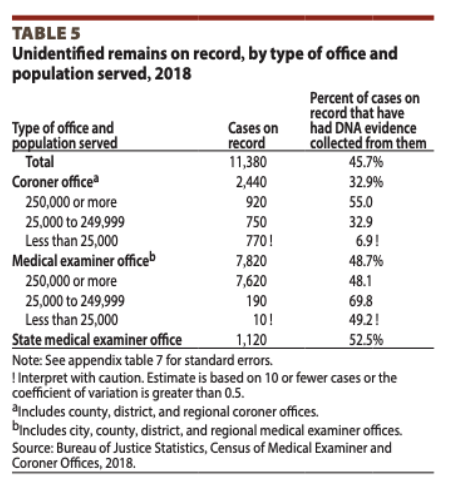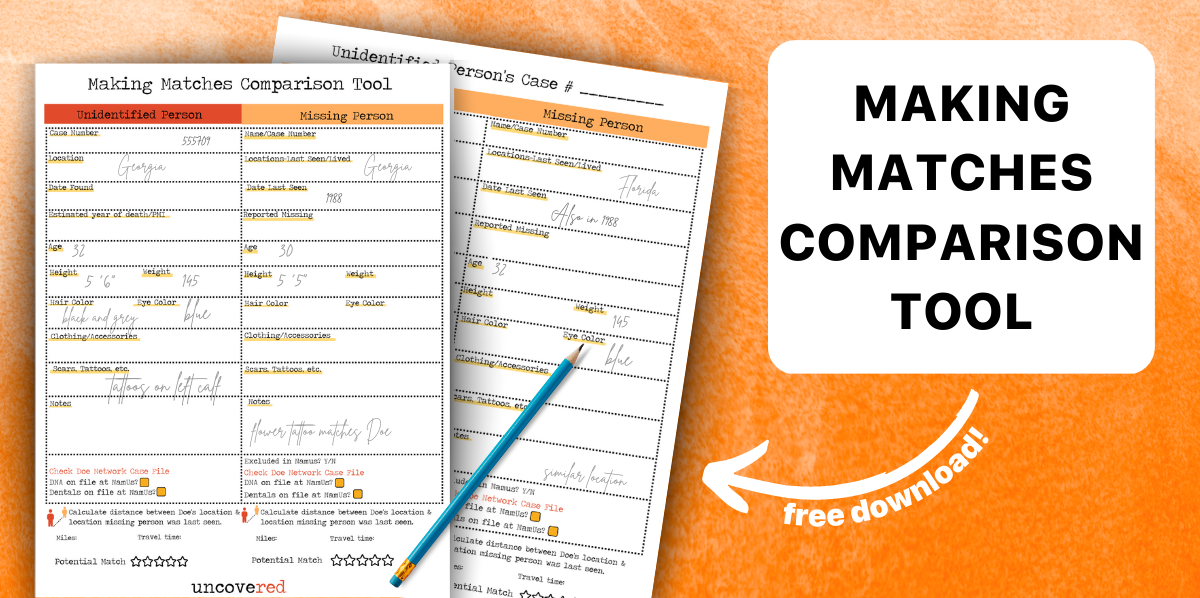By: Dana Poll, MLIS
Researching Doe cases requires an eye for detail, organizational skills, and a great deal of patience. If you are up for the challenge, this information and free resource will get you on your way to making matches like a professional.
Enter your email to get our Making Matches Comparison Tool
In 2005, the Bureau of Justice Statistics conducted a nationwide Survey of Medical Examiners and Coroners’ Offices. One of the many statistics gathered in this survey was the number of unidentified persons that were received by these offices. This was the first time unidentified human remains had ever been counted. The results of the survey were sobering.
The census revealed that over 600,000 individuals go missing in the United States every year. Many of these missing adults and children are found quickly, alive, and well but unfortunately, tens of thousands of these individuals remain missing. Adding to the number of missing persons are the 4,400 unidentified bodies recovered each year. Approximately 1,000 of these bodies remain unidentified.
This is the cumulative problem that Nancy Ritter, writer/editor at the National Institute of Justice and Editor of the NIJ Journal, called the nation’s silent mass disaster. In her article, Missing Persons and Unidentified Remains: The Nation’s Silent Mass Disaster, Ritter wrote, “Very few people—including law enforcement officials—would think of the number of missing persons and unidentified human remains in our nation as a crisis. It is, however, what experts call “a mass disaster over time.”
The most recent survey was conducted in 2019. Data collected was from 2018.
Data in this report come from the Bureau of Justice Statistics’ 2018 Census of Medical Examiner and Coroner Offices (CMEC), which collected data on personnel, budget, workload, and policies of all ME/C offices in the United States. The 2018 CMEC is the second in a series that began in 2004.
As of 2018, there were 11,380 cases of unidentified human decedents on record. Medical Examiners and Coroners’ offices collected DNA evidence in about 46% of cases with unidentified human remains. (See Table Below)

What are the steps for searching in NamUs?
Researching Doe cases requires an eye for detail, organizational skills, and a great deal of patience. If you are up for the challenge, there are databases that can help.
NamUs is a national information clearinghouse and resource center for missing, unidentified, and unclaimed person cases across the United States. Funded and administered by the National Institute of Justice and managed through a contract with RTI International, all NamUs resources are provided at no cost to law enforcement, medical examiners, coroners, allied forensic professionals, and family members of missing persons. Ten states have passed legislation mandating the use of NamUs for missing and/or unidentified persons cases.
- Arizona
- Arkansas
- Illinois
- Michigan
- New Mexico
- New York
- North Carolina
- Oklahoma
- Pennsylvania
- Tennessee
- Texas
- Washington
- West Virginia
Step 1: Create a NamUs account
This will give you access to a dashboard where you can track missing, unidentified, and unclaimed persons’ cases that interest you.
Step 2: Open two windows
Open the missing search page in one window and the unidentified search page in another so you can easily compare missing person files with unidentified persons’ files.
Tips: Be sure to review these important data points.
- Doe’s Date of Discovery with the date the Missing Person was Last Seen — be sure to review the Doe’s estimated postmortem interval (PMI) if available.
- Doe’s Location of Discovery with Where the Missing Person was Last Seen
- Doe’s Estimated Age when Discovered with the Missing Person’s Age when Last Seen
- Doe’s Estimated Height/Weight/Hair and Eye Color (if available) with the Missing Person’s Height/Weight/Hair and Eye Color
Do you know the exact height and weight of all of your family members? Remember, sometimes a missing person’s height and weight are best guesstimates.
Step 3: Using advanced search
NamUs Advanced Search provides many options that will help you narrow your search. Advanced searches allow you to create customized search queries. A search for identifies like appendectomy scar, butterfly tattoo, Grateful Dead shirt, cowboy boots will deliver a list of cases that contain those terms. Read the NamUs Advance Search Guide to learn more.
Tips: In cases where a person is unrecognizable due to decomposition or complete skeletonization, the physical description of the Doe is determined by the medical examiner or the coroner. Formulas are used to estimate weight, height, and age. This is not an exact science and sometimes the bones that could be used to determine height are missing.
In order to account for the estimated weight, expand your search by 10 to 20 lbs in either direction. If a missing person is said to have weighed 140 lbs, conduct searches for an Unidentified Person with an estimated weight between 120 and 160. You might also try adding/subtracting a few inches to an estimated height and a few years to the age range when conducting searches.
Step 4: Compare, Contrast, and Rule Out
Depending on your results list, this may take some time. It is important to review all of the information contained in each file and incorporate the tips below. Don’t forget to log in to your NamUs account and track the cases, you can not rule out, on your Dashboard.
Tips: Be sure to check the Comparisons tab in the Unidentified person’s case file.
If the missing person is listed on the Doe’s page or visa versa the two cases have already been compared and ruled out.
If you are comparing a missing person’s photo to a reconstruction or a sketch of an unidentified person the hairline, nose, lips, and ears may be educated guesses.
If you are comparing a photo of a missing person with an autopsy photo of an unidentified person, isolate and compare features. Make note of the space between the eyes, the nose, and the upper lip. Look at the jawline, the chin, the eye sockets, and the arch of the eyebrows, and pay special attention to the size and shape of the ears. Are the lobes attached or detached? It has been said that a person’s ears are almost as unique as their fingerprints.
Step 5: Submitting a Potential Match
If you can not rule out a potential match, review the cases again to be sure the unidentified person was discovered after the person went missing. Really think about the timing, the circumstances, and the location. Ask yourself, does this scenario make sense?
If you believe it does, you should submit a comparison request to the NamUs Regional Director assigned to the case (info on the Contacts page) and the Law Enforcement contacts listed on the Contacts page in both the Unidentified Person’s and the Missing Person’s case file.
Information to include in your Comparison Request for NamUs
These items are critical for identifying comparisons in your research of Doe cases when using NamUs.
Missing Person:
- Name
- NamUs Case #MP
- NamUs Link to Case File
Unidentified:
- NamUs Case #UD
- NamUs Link to Case File
Reason for Request:
- Explain why you think the MP and UD could be a match.
- Mention that you have checked the comparisons page, and this potential match has not been excluded.
- Ask them to review the cases and thank them for their consideration. (You may or may not receive a response).
Tips
- Keep a record of your submissions.
- Check NamUs periodically to see if your potential match has been added to the comparison list.
- If it hasn’t, send another email or call and request an update on the status of your request.
What resources are available for researching Doe cases?
Established in 2019, the Uncovered Database contains more than 50,000 case files of missing, murdered, and unidentified people. Anyone can contribute information to the database, including photos, newspaper articles, digital news links, podcasts, etc. Crowdsourcing information helps to move cold cases forward.
When researching unidentified person cases, multiple databases must be used. Search the Uncovered database in conjunction with NamUs and the following resources in order to identify and compare potential matches.
The Doe Network is a 100% volunteer organization devoted to assisting investigating agencies in bringing closure to national and international cold cases concerning Missing & Unidentified Persons. Established in 1999, the Doe Network’s mission is to give the nameless back their names and return the missing to their families. As of December 31, 2021, they have assisted in solving 113 cases.
If you want to compare cases within The Doe Network database, open an unidentified search window and a missing person search window. You can search unidentified person cases by year discovered or by state and missing persons cases by the name, year missing, or by state. When available, the case file includes a link to the NamUs file and other related sources. Most Doe Network case files indicate if dental and DNA are available.
Case Comparison requests can be submitted to the Doe Network’s Potential Match Panel via their Potential Match Submission form. The decision to either accept or reject the match is based on such considerations as timing, distance, age, race, height/weight, hair/eye color, tattoos, clothing, medical information (i.e. scars, previous surgeries, medical conditions), and overall circumstances surrounding the disappearance of the missing person. Panel members will also compare the facial features of the missing person to any postmortem pictures or facial reconstructions that might be available.
If a match is accepted by a simple majority of panel members, the match is then submitted to the Law Enforcement agency or agencies involved in the case.
Authenticating a match can often take years. If the potential match results in a confirmed match, the submitter will be notified upon permission from the Investigating Agency.
The Doe Network recently established The Justice Support Unit. The Justice Support Unit is the foundational arm of The Doe Network which will provide support services for missing & unidentified related needs.
The Charley Project profiles the cold cases of over 15,000 missing people. It does not actively investigate cases; it is primarily a publicity vehicle for missing people who are often neglected by the press and forgotten all too soon. The Charley Project can be searched by name, location, or date of disappearance. A Resolved and Updated Case list is available on the site. You can also find a list of State and Local Missing Persons Records and Facebook Pages for Missing Persons. The Charley Project does not accept comparison requests.
More Resources for Doe Cases
- Florida Unidentified Descendents Database
- National Center For Missing and Exploited Children
- Black and Missing Foundation
- DNA Doe Project
- DNAsolves.com
- Reddit: r/grateful doe
- Crimehound on Youtube
- Podcast: True Crime PI -Season 1-Cobb County Jane Doe
- Book: Cold Case Research Resources for Unidentified, Missing, and Cold Homicide Cases
Love this post? Meet the Author.
Dana Poll, MLIS is the Head of Community at Uncovered and the creator and host of True Crime P.I., an investigative podcast that explores missing and unidentified persons’ cases from the 70s, 80s, & 90s. As a founding member of the Uncovered community, Dana’s goal is to help families who have been “forced to carry the unbearable burden of not knowing.”
Uncovered has built a community for thoughtful true crime discussion, advocacy, and comprehensive cold case research. We are the hub for novice and experienced researchers alike, helping members further develop their citizen detective skills. Sound like something you’re interested in? Join our community. Together, we can make a difference.

